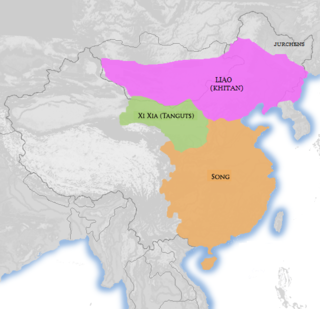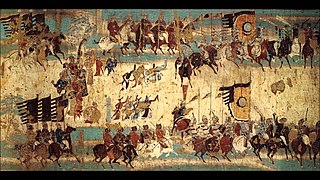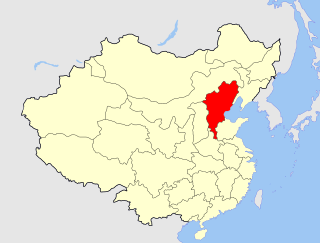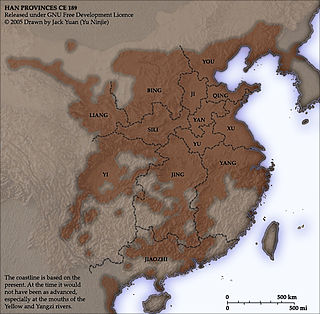 W
WAncient Chinese states were typified by variously sized city-states and territories that existed in China prior to its unification by Qin Shi Huang in 221 BCE. In many cases these were vassal states and fiefs established in the fengjian system characterized by tributes paid to the ruling Zhou dynasty. Such states and fiefs would again emerge during later dynasties as a political expedient when required. Rulers of these states were known as zhuhou.
 W
WThe Liao dynasty was an empire established by the Khitans. This article discusses the provincial system that existed within the Liao dynasty from the early 10th century until the fall of the empire in 1125, in what is now North China, Northeast China and Mongolia.
 W
WThe Tang dynasty administered territory using a hierarchical system of three descending divisions: circuit dào (道), prefecture zhōu (州), and county xiàn (縣). Prefectures have been called jùn 郡 as well as zhōu 州 interchangeably throughout history, leading to cases of confusion, but in reality their political status was the same. The prefectures were furthered classified as either Upper Prefectures, Middle Prefectures, or Lower Prefectures depending on population. An Upper Prefecture consisted of 40, 000 households and above, a Middle Prefecture 20, 000 households and above, and a Lower Prefecture anything below 20, 000 households. Some prefectures were further categorized as bulwark prefectures, grand prefectures, renowned prefectures, or key prefectures for strategic purposes. A superior prefecture was called a fu (府).
 W
WThe Yuan dynasty was a vast empire founded by Mongol leader Kublai Khan in China. During its existence, its territory was divided into the Central Region (腹裏) governed by the Central Secretariat and places under control of various provinces (行省) or Branch Secretariats (行中書省), as well as the region under the Bureau of Buddhist and Tibetan Affairs. In addition, the Yuan emperors held nominal suzerainty over the western Mongol khanates, but in reality none of them were governed by the Yuan dynasty due to the division of the Mongol Empire.
 W
WThe Beiting Protectorate-General, initially the Beiting Protectorate, was a Tang dynasty protectorate created in 702 to control the Beiting region north of Gaochang in contemporary Xinjiang. Wu Zetian set up the Beiting Protectorate in Ting Prefecture and granted it governorship over Yi Prefecture (Hami) and Xi Prefecture (Gaochang). The Beiting Protectorate ended in 790 when Tingzhou was conquered by the Tibetan Empire. In 2014 the Beiting city ruins were designated a part of the Silk Road UNESCO World Heritage Sites.
 W
WA circuit was a historical political division of China and is a historical and modern administrative unit in Japan. The primary level of administrative division of Korea under the Joseon and in modern North and South Korea employs the same Chinese character as the Chinese and Japanese divisions but, because of its relatively greater importance, is usually translated as province instead.
 W
WA circuit was a historical political division of China and is a historical and modern administrative unit in Japan. The primary level of administrative division of Korea under the Joseon and in modern North and South Korea employs the same Chinese character as the Chinese and Japanese divisions but, because of its relatively greater importance, is usually translated as province instead.
 W
WA jùn (郡) was a historical administrative division of China from the Eastern Zhou until the early Tang dynasty. It is usually translated as a commandery.
 W
WHuguang was a province of China during the Yuan and Ming dynasties. It was founded by the Yuan dynasty in 1274. During the Yuan dynasty it included the areas of modern Hubei south of the Yangtze river, Hunan, Guizhou, and Guangxi. During the Ming dynasty it came to include just the modern provinces of Hubei and Hunan, in the process adding areas north of the Yangtze. It was partitioned in 1644 by the newly established Qing dynasty, becoming the provinces of Hubei and Hunan, which were administered by the viceroy of Lianghu.
 W
WThe Protectorate of the Western Regions (simplified Chinese: 西域都护府; traditional Chinese: 西域都護府; pinyin: Xīyù Dūhù Fǔ; Wade–Giles: Hsi1-yü4 Tu1-hu4 Fu3) was an imperial administration imposed by Han China – between the 2nd century BCE and 2nd century CE – on many smaller and previously independent states, which were known in China as the "Western Regions" (Chinese: 西域; pinyin: Xīyù; Wade–Giles: Hsi1-yü4).
 W
WZhili, alternately romanized as Chihli, was a northern administrative region of China from the 14th-century Ming dynasty until 1911, when the region was dissolved, converted to a province, and renamed Hebei in 1928.
 W
WZhou were historical political divisions of China. Formally established during the Han dynasty, zhou exist continuously until the establishment of the Republic of China in 1912—a period of over 2000 years. Zhou were also previously used in Korea, Vietnam, and Japan .